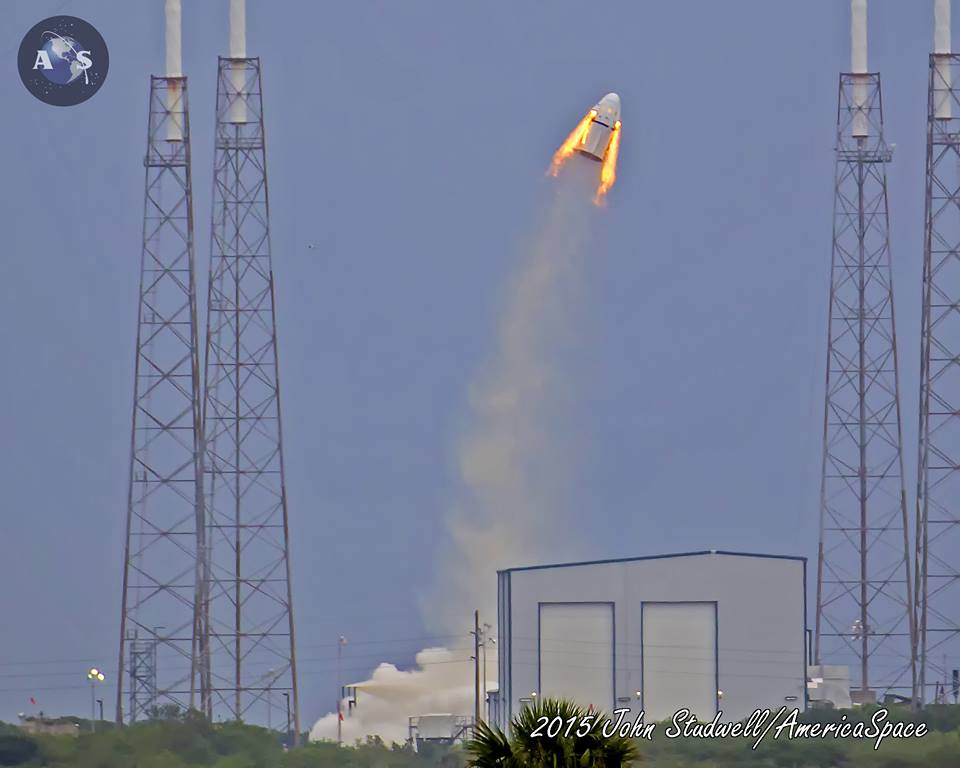
SpaceX has successfully conducted its long-awaited Pad Abort Test of a mockup Crew Dragon spacecraft, ahead of the In-Flight Abort, later this summer, and its eventual plan to deliver U.S. astronauts to the International Space Station (ISS), aboard a U.S.-manufactured spacecraft, and from U.S. soil, for the first time since the end of the shuttle era. Delayed since early April, the test got underway with spectacular speed at 9 a.m. EDT Wednesday, 6 May, as the spacecraft punched away from Space Launch Complex (SLC)-40 at Cape Canaveral Air Force Station, Fla., rising to a predicted altitude of 5,000 feet (1,500 meters) in a matter of a few seconds, before its crew capsule separated from the unpressurized “trunk” and completed a parachute-assisted splashdown in the Atlantic Ocean. Early indications are that the 102-second test—which showcased a system that SpaceX and NASA fervently hope they will never need to use with a crew aboard—ran without a wrinkle.
As described in AmericaSpace’s two-part preview/history article—and in our recent portfolio of imagery of the Dragon vehicle at the pad—this critical test has been a long time coming. Originally targeted to occur in early April, it was pushed back by more than a month, due to an issue with helium pressurization bottles aboard Falcon 9 v1.1 hardware, which forced a prudent SpaceX to delay an earlier mission, carrying the TurkmenÄlem52E/MonacoSat payload to Geostationary Transfer Orbit (GTO). Since both missions required the use of SLC-40, the delays had a ripple-like effect on the Pad Abort Test.
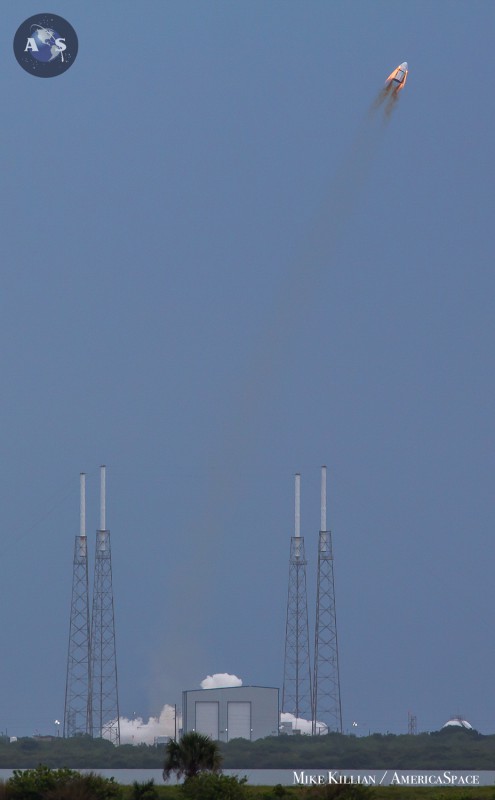
In the immediate aftermath of the TurkmenÄlem52E/MonacoSat launch on 27 April, efforts to reconfigure SLC-40 for the ground-level installation of the Crew Dragon capsule and unpressurized trunk got underway. On 30 April, the high-level catenary lines for lightning protection were removed and a truss structure to support the spacecraft at ground level was installed over SLC-40’s flame trench. At about the same time, the target date for the Pad Abort Test was moved 24 hours to the right, to Wednesday, 6 May, with weather conditions anticipated to be 70 percent favorable. The 7.5-hour “window” was scheduled to open at 7 a.m. EDT, about 22 minutes after local sunrise.
In readiness for the test, SpaceX highlighted that the primary Eastern Range weather constraints centered upon the risks posed by “Phase II Lightning”—a warning for which is typically issued when lightning is either imminent or occurring within 5 miles (8 km) of the launch site, requiring the termination of all lightning-sensitive operations—as well as the possibility of winds in excess of 25 knots.
“Winds have become gusty out of the east and will remain so for the next couple of days as a low-pressure area develops south-east of Central Florida,” it was highlighted by the 45th Weather Squadron at Patrick Air Force Base in an update on Monday. “The increase in winds also increases the threat of showers along the Space Coast. Showers will be most prevalent in the morning hours and typically diminish after noon. On Wednesday, the low-pressure area will drift north and east, relaxing the pressure gradient, which will result in lower wind speeds over the Spaceport.” Maximum winds to 5,000 feet (1,500 meters) were expected to be easterly at 20 knots, producing a 70 percent likelihood of acceptable conditions on Wednesday. That probability was expected to improve to 80 percent favorable on the backup day on Thursday, as the low-pressure region continues to move northwest and winds continue to weaken. In the event of a 24-hour scrub, it was expected that the maximum winds to 5,000 feet (1,500 meters) on Thursday will be north-easterly at 17 knots.
Yesterday (Tuesday), the 21,000-pound (9,525-kg) Crew Dragon vehicle was transported to SLC-40 and completed a satisfactory Static Fire Test of the eight SuperDraco thrusters, embedded within its side walls. These hypergolic thrusters, which completed their qualification testing in May 2014 at SpaceX’s Rocket Development Facility in McGregor, Texas, produce a combined impulse in excess of 120,000 pounds (54,430 kg) and in the event of an abort scenario are designed to pluck the Dragon spacecraft away from its failed booster and propel it safely away to an altitude of about 5,000 feet (1,500 meters) in just six seconds. This would be followed by the separation of the trunk and crew capsule, the latter of which would parachute to a safe oceanic landing, about 6,000 feet (1,800 meters) to the east, guided by drogues and three main canopies.
With a 7.5-hour window in which to accomplish the short Pad Abort Test, SpaceX opted to refine T-0 from 7 a.m. to 9 a.m., pending the weather situation. “The weather is currently Go for today’s #PadAbortTest,” noted AmericaSpace’s Twitter profile at 8:30 a.m. “Controllers are currently working no technical constraints. #SpaceX.”
Opening SpaceX’s live webcast a few minutes later, Falcon 9 Product Director John Insprukter told his audience that the team was “Go for Launch,” but stressed that “we continue to watch cloud levels and the possibility of lightning in the area.” By this stage in the countdown, final checks aboard the Dragon vehicle itself, including Radio Frequency (RF) tests, had been completed. At T-13 minutes, in a fashion which closely mirrored the business end of a Falcon 9 v1.1 countdown, came the standard “Go/No-Go” poll of all flight controllers, with all stations reporting their readiness as “Go,” with a note of caution from the Launch Director, pending resolution of range weather. Mr. Insprukter explained that the “charged atmosphere around the launch complex” posed a lightning risk, adding that if the Terminal Countdown did not commence at T-10 minutes, the clock would likely be recycled back out to T-20 minutes for a follow-up attempt, later in Wednesday’s window.
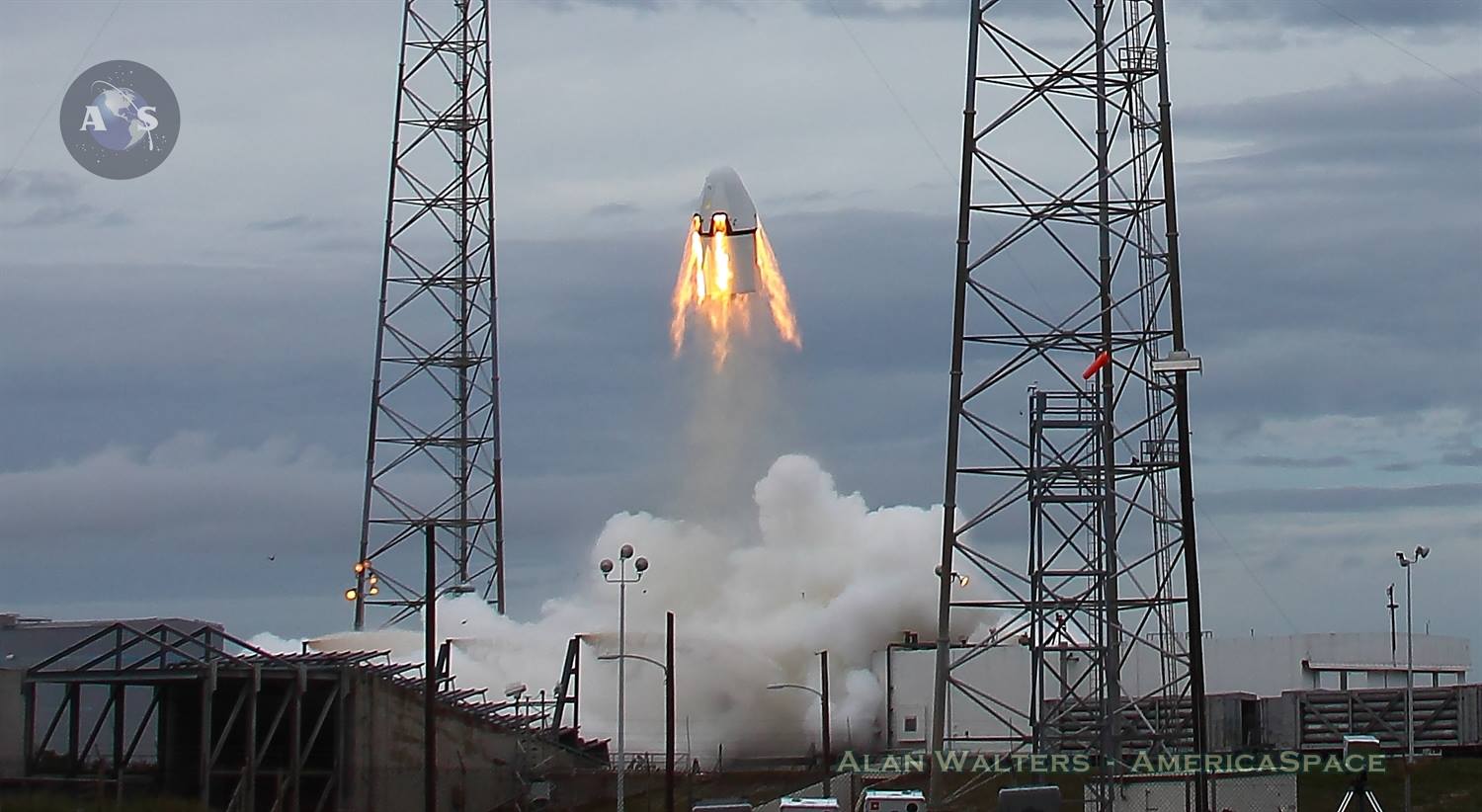
However, despite increasingly gloomy skies over the Cape, the Terminal Countdown kicked off at 8:50 a.m. and the Inertial Measurement Units (IMUs) were confirmed in proper alignment about 60 seconds later. At 8:54 a.m., Dragon was placed onto internal power. Finally, at T-2 minutes, the Launch Director issued a definitive “Go for Launch.” Keenly aware of the sheer speed with which the Dragon would punch away from the launch complex, all cameras and eyes were intensely focused on the small, bullet-shaped spacecraft, as it entered the last seconds before its most complex test to date. As had been anticipated, the event itself was brief, but spectacular, and also spectacularly successful.
“Launch!” came the call at T-0 and all eight SuperDracos flared instantaneously to life from the side walls of the spacecraft, propelling it directly upwards to about 5,000 feet (1,500 meters) at a much faster rate of ascent than normally seen during rocket launches. This severely tested the reaction times and camera reflexes of the assembled photojournalists.
“I was forced to frame the remote cameras ‘wider’ than usual, just to give myself more chance of actually capturing a shot or two of Dragon getting off the pad,” explained AmericaSpace Editor Mike Killian, in response to a query about his camera set-up preparations. “With a rocket, those first five seconds or so is a slow ascent, but Crew Dragon … will jump off and be at altitude and near engine cutoff in the same amount of time. Since there is a delay between the sound trigger and camera’s first shot, and considering the one second Dragon will be in frame of the remotes, I’m hoping just to get anything. It will be that fast!” AmericaSpace’s John Studwell handled the photography in a similar fashion to his prior experience covering rocket and shuttle launches: “Only thing I consciously did was raise my ISO and likewise my shutter speed to accommodate the quick ascent,” he said. “However, I really didn’t experience much of a difference from a status quo launch.”
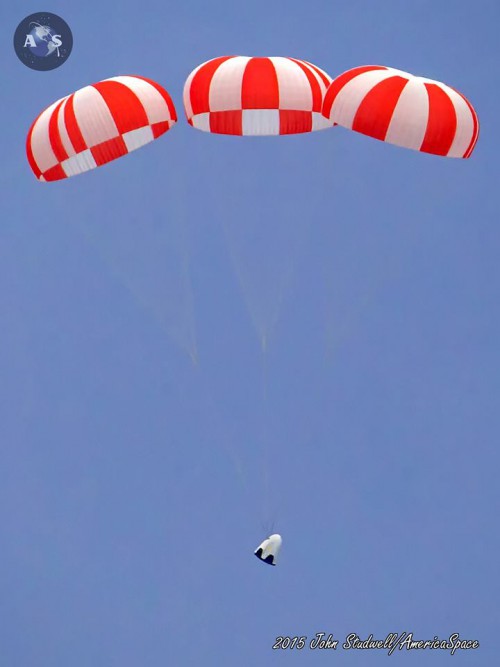
The response on Twitter, including comments from current and former astronauts, was virtually immediate. “Looked very survivable,” remarked Canada’s first ISS Commander, Chris Hadfield with admiration, whilst Expedition 36/37 crew member Karen Nyberg added a humorous note from her young son, who was fearful that the capsule might be struck by a whale in the ocean. With characteristic enthusiasm, former shuttle and ISS astronaut Garrett Reisman—who now serves as SpaceX’s Director of Crew Operations—tweeted: “That was Friggin awesome!!! Go Dragon!!!”
Specific focal points for today’s test included Sequencing, Closed-Loop Control, Trajectory, and External and Internal Environments. It will have sought to demonstrate the Dragon’s proper sequencing of an on-pad abort timeline and the execution of multiple commands within a very few seconds. Moreover, no more than two SuperDracos had ever been fired in unison before today’s test and trajectory data and measurements of external and internal conditions aboard the spacecraft “to help ensure safe conditions for crew transport” were of primary importance.
Although today’s test appeared to pass with perfection, the in-depth engineering analysis will likely take several weeks, ahead of SpaceX’s next goal of an In-Flight Abort, using the same Dragon capsule, later this summer. Yet the Pad Abort Test is a significant milestone as the Hawthorne, Calif.-based launch services provider aims to deliver U.S. astronauts to the International Space Station (ISS), aboard a U.S.-built spacecraft, and from U.S. soil, for the first time since the close of the shuttle era.
Whilst highly successful, and certainly visually spectacular, today’s test actually served to validate a mechanism which, although potentially life-saving, would only ever be used in the most harrowing of circumstances. And it is the fervent hope and prayer of SpaceX, NASA, and the astronauts who will someday fly Crew Dragon that the mechanism never needs to be used for real with a crew aboard.
BELOW PHOTOS CREDIT: AmericaSpace / Alan Walters / Mike Killian / John Studwell
Want to keep up-to-date with all things space? Be sure to “Like” AmericaSpace on Facebook and follow us on Twitter: @AmericaSpace
Missions » ISS » CCDev » Crew Dragon PAT »




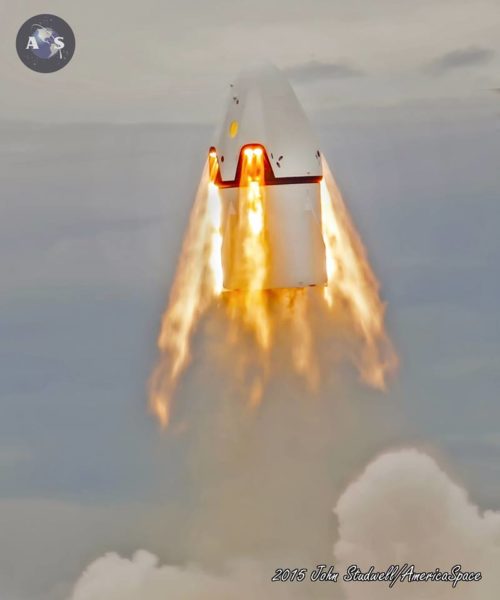
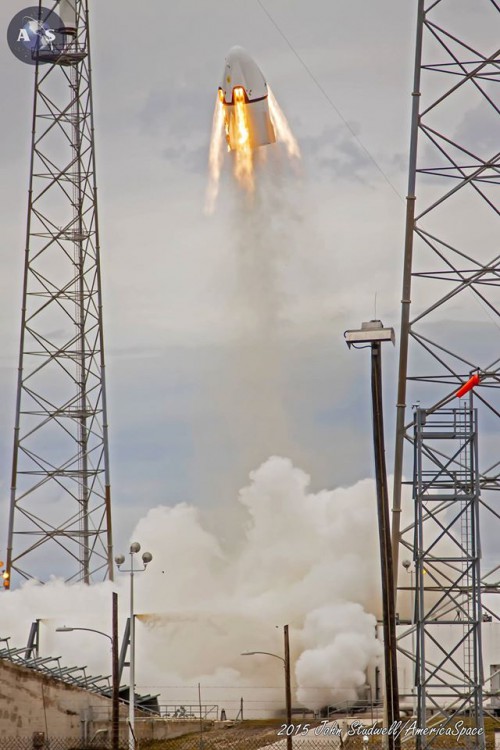
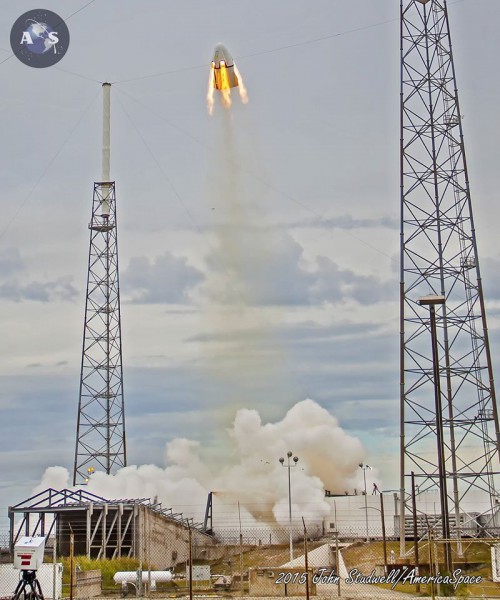
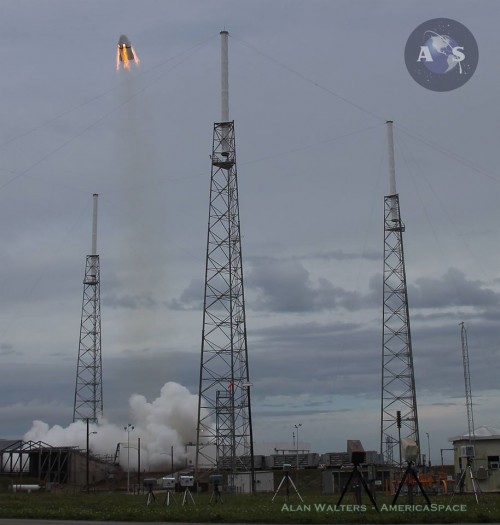
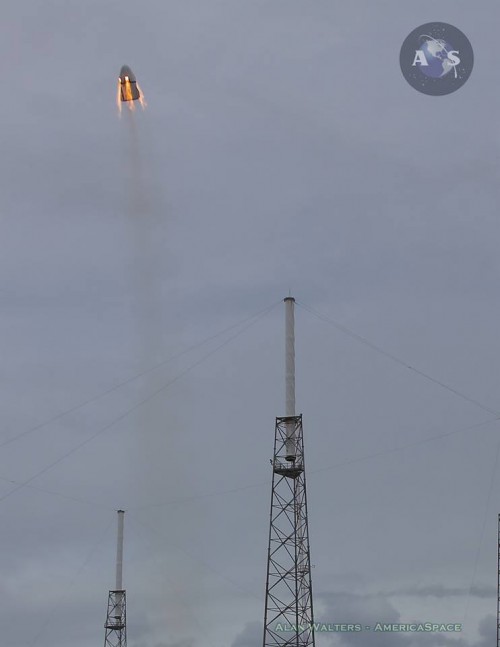
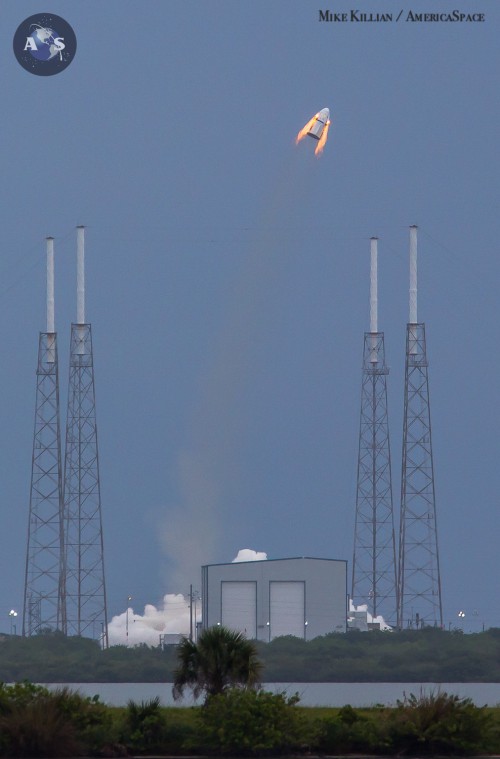
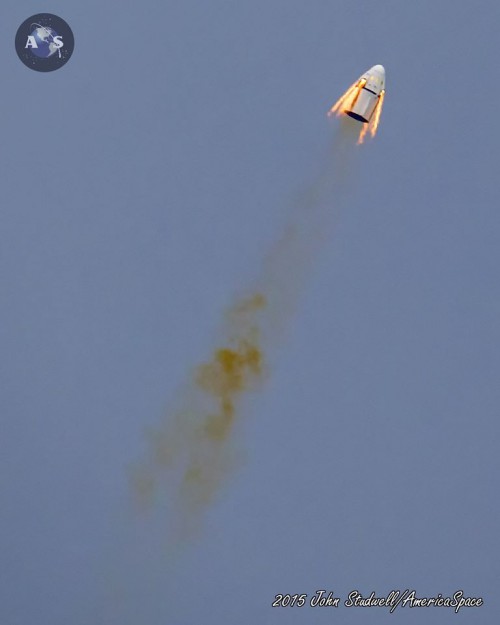
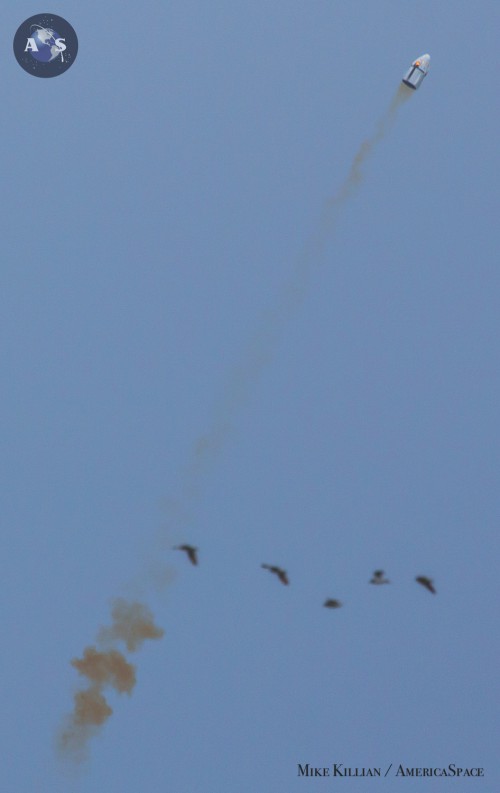
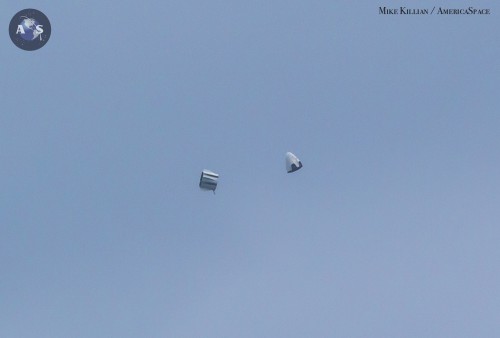
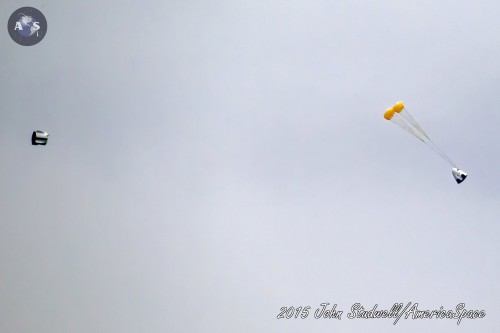
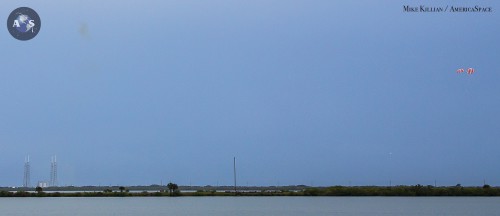
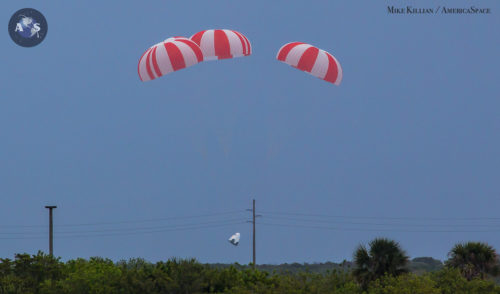
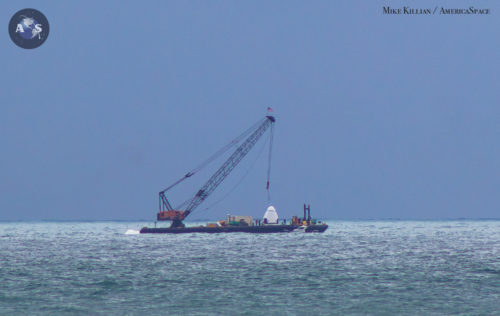
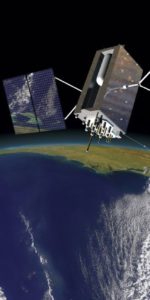
Ok so they are calling this a test…Is there a plan that would not use a parachute just the Super Draco engines in the future?
That’s exactly the plan after the first initial crewed missions, propulsive landings on land
Not for aborts. All they’ve ever spoken about for aborts are parachute splashdowns, which makes sense as the abort uses the same propellant supply planned for landing use.
So is the issue then that they would not have enough fuel to both do an abort and do a propulsive landing?
Correct. At an abort, all the propellant is used to to ensure maximum distance to the booster. Nothing left to soften the landing.
Yes Google SpaceX Dragonfly. Although not a launch abort they will be using the SuperDraco for controled landing.
I agree that was frigging awesome.
SpaceX is the future of space travel.
Toxic dragon abortion complete.
I think the subject of SpaceX using hyperglolic fuel has been thoroughly discussed.
Hi Jim,
Here is a non fuel question.
I do not know the SpaceX terminology, but in order to land (what in the vernacular I am familiar with would be) the service module separated from the crew module.
In an eventual powered land landing the service module would have to stay attached.
How is the Dragon vehicle to reenter in that configuration (that is, where is the heat shield)?
In SpaceX terminology it’s a “trunk.”
It’s not a service module and doesn’t carry fuel, or life support oxygen. The service module equivalent function it does have is supplying electricity on orbit, via solar panels on its surface (as opposed to the panels that extend out the sides of the trunk on the cargo dragon). Unpressurized cargo can be carried in the trunk.
The the propellants for the Draco thrusters (RCS) and Super Draco thrusters (Abort and landing) are not in the trunk, they’re in the bottom of the capsule, between the pressure vessel and the head shield.
The heat shield is on the bottom of the capsule.
During a “normal” (non-aborted) mission profile, the trunk would be separated from the capsule before re-entry and burn up, like the trunk of the cargo Dragon.
The reason the trunk aborts with the capsule is that it is providing aerodynamic stability during the boost phase of the abort. Its four fixed fins put the center of pressure well behind the CG of the capsule/trunk stack.
OK.
But (and I am not being argumentative) where are the Super Drago Engines (not the fuel tanks, but the engines themselves located?
There are 4 pods on the sides of the capsule, with 2 engines each. There are fairings covering the engines, and they exhaust down and outward from about 1/3 of the way up the side of the capsule. The first picture after the end of the above article has a great photo by John Studwell where their placement is very visible.
Thanks.
Which I hope explains the disjointed thanks below.
You’re welcome. Hope it wasn’t a problem to butt in on a question directed at someone else. Sometimes the excited hand-raising 4th grader inside of me gets the better of me.
No problem at all.
Aw, how cute, Gary. 🙂 We’ll let you use the toxic solids instead if you want.
I cannot dispute that solids have toxic byproducts, but since the subject of toxicity has been discussed at length there will be no toxic conversation comparing the two originating with my reply to you. Not taking your bait Lars. Not cute.
Thanks.
Speaking as a SpaceX agnostic (i.e. I’m neither an unquestioning fan nor a committed critic), this was a pretty good looking test. However, I have heard elsewhere that the test was a bit “off nominal” with the engines not burning quite as long as expected resulting in the capsule not traveling as high or as far as intended. I know it’s early days as far as analyzing the engineering data but I wonder if this might result in some changes for the upcoming in-flight abort test or even force a second pad abort test.
I doubt a second pad abort test will be required. They succeeded in the test objectives, and got plenty of data to address minor propulsion issues. In a way the early cutoff of one SD thruster (it appeared) give the software a chance to demonstrate that it can handle propulsion anomalies.
According to Elon (https://twitter.com/elonmusk/status/596053122587365376), the velocity at SD cutoff was 155m/s, on the low end but still within the 150-180m/s range given in advance of the test.
Thanks for the updated info. So it wasn’t “below nominal” as I read somewhere, it is actually “low nominal”. Given that I tend to agree with your assessment that another pad abort test will be needed.
“And it is the fervent hope and prayer of SpaceX, NASA and the astronauts who will someday fly Crew Dragon that the mechanism never needs to be used for real with a crew aboard.”
Sorry, but it’s gonna happen eventually. Hope and prayer did not work for the Shuttle. As for being “used for real”, if SpaceX is serious about making landings (which I doubt) then it is certainly going to be used. It will not have a trunk acting as a shuttlecock and if it burps at 50 feet and crashes the residual in the fuel tanks makes a mockery of crew survivability. It just does not make sense in terms of risk. Which is why I suspect they will stick to what is really the unbeatable return-to-water-planet-recovery: the spashdown. However a similar situation exists for the V-22 Osprey- that monstrosity cannot autorotate and it is in service so such stupidity is possible I guess. Never underestimate the power of greed.
As I have repeatedly stated since early last year when I started commenting on this system- and not a single word from anyone, anywhere I have seen, saying what I am saying here- I believe the purpose is not primarily escape, it is boosting tourists stations in orbit. SpaceX and Boeing will not admit this (not yet) because it makes clear that safety is taking a back seat to profit- just like in the shuttle program. I do not like that devious and deceptive marketing is hiding their true intent from the public. And using tax dollars (70 million dollars for this faux escape system) to subsidize future private tourist space stations for the uber-rich.
How exactly will an abort/landing system take “tourist stations” into orbit? Can it accomplish something the giant rocket underneath cannot?
I am not even going to reply unless you state the question again using my words and not yours. I did not say that and putting words in my mouth right off the bat indicates you just want to argue.
“I believe the purpose is not primarily escape, it is boosting tourists stations in orbit. ”
How can that statement mean anything else?
Here is a hint: what is the difference between boosting something already “in” orbit and being boosted “into” orbit? If you are going to question someone on a comment about space stations and take their time maybe you should find out something about space stations first. The don’t just stay up there and go in circles forever- LEO is not really space. I am not going to do your homework for you.
I apologize Larry, I am so used to being attacked on these forums that I just assume people are not asking honest questions and instead being typical NewSpace cyberthugs.
Low Earth Orbit has traces of atmosphere in it because it is not that far up and in my view should be thought of as a very high altitude low drag domain beneath the Van Allen belts- not really even worthy of being called space. Low drag means there is drag and space stations are inexorably dragged down and must be periodically boosted back into their proper orbits. Because there is so much junk up there they also have to occasionally do emergency avoidance maneuvers. Providing a space station with it’s own propulsion system is not practical because such systems have to be refueled and last for years and this is so far just too difficult.
Since much NewSpace dogma depends on “depots” the fact that refueling even a hypergolic system, let alone cryogenic propellants, has never been done in thirty years of space stations makes this a verboten subject. Throwing the B.S. flag on the depot miracle draws immediate and intense criticism.
The solution is to move the station around with the engines on the spacecraft that are docked. The ISS is moved around with the engines on the docked Russian spacecraft as far as I know. And that is why, in my view, the toxic dragon and Boeing tourist bus have these systems instead of escape towers.
http://en.wikipedia.org/wiki/Orbital_station-keeping
But space craft already do that now with the ISS. There is no reason to develop a complex new system JUST to do that.
While I don’t share Gary’s view that station boosting is the only and or hidden reason CST-100 and Crew Dragon have integrated launch abort systems there are reasons new systems for space station boosting may have value.
ESA won’t be making any more ATVs, so they aren’t available for ISS boosting.
The US may well operate the ISS after the end of Russian involvement. Certainly there would be political pressure to use a US based solution for boosting, rather than having to contract for Progress reboosts (which I don’t think will even be possible if Russia removes their sections with the Soyuz docking ports).
Additionally if Bigelow has one or more private stations in LEO, they will need occasional boosting. Bigelow has been talking about using CST-100 and Crew Dragon to ferry people to and from, whether they be commercial, government clients or space tourists.
“Additionally if Bigelow has one or more private stations in LEO, they will need occasional boosting.”
Exactly.
Gary,
Many thanks for your comments.
“Fervent hope and prayer” was a figure of speech and, although the possibility of an accident exists, I’m sure that it is everyone’s hope and prayer that nothing untoward happens on a piloted mission. It might happen eventually, but then again it might not, because of the very system that was demonstrated yesterday.
Yes, the Shuttle suffered two catastrophic losses, but flew a much longer lifespan and number of missions than Crew Dragon is likely to fly, which increased its overall probability of experiencing a LOCV. As for “certainty” that the abort system will be used, who can know? The Shuttle never required the use of an RTLS or an AOA, but needed one use of an ATO. It also suffered four on-the-pad engine shutdowns, but none of these required an immediate emergency egress by the crew. Mercury delivered each of its crews to orbit, as did Gemini. Apollo never suffered a launch abort with a crew, responding well in the aftermath of the Apollo 12 lightning strike and recovering from an engine-out during the Apollo 13 ascent, which did not seriously affect the crew’s delivery into LEO.
To date, the Falcon 9 v1.1 has a good track record for delivering its payloads safely to orbit. Yesterday’s test appeared to go well, but of course, there is a chance that disaster could grip any mission. All space systems are built by humans, and humans are by their nature, fallible.
Thanks for your comments.
Ben
Thank you for your article Ben. I don’t want anyone to die. But if SpaceX is going to be using this vehicle to carry people to tourist space stations (and they will not deny this) then your claim it is not likely to fly as many human crewed missions as the shuttle- and thus have a lower likelihood of the need to abort- is questionable.
Soyuz has flown over 600 times and while not all were manned and there were failures the escape tower has been used only once- for a pad fire. It may be that with numbers like this SpaceX management feels “justified” in using this multi-purpose design. Unfortunately, most organizations have a habit of talking themselves into just about anything if it has to do with the possibility of making more or spending less money. Sooner or later they find out there is no cheap.
Also, as a journalist, I trust you are thick skinned enough for me to say you have to be careful of the statements you make because everyone is a critic and you will seldom get away with any mistakes in reasoning. You might want to examine the two sentences you just wrote concerning hope and prayer.
Regards, Gary
What happens at high altitudes when the capsule and the trunk separate?
The rockets would have fired and the trunk released.
With little atmospheric drag the trunk would follow the capsule with a possibility of a collision.
Is there a system to separate the two other than with a aerodynamic brake?
Sorry, ignore this comment.
The normal re-entry separation system would be used.
The parachute deployment was even more violent than the abort test itself- Orion was much smoother
If there was really an Anthropometric Test Dummy (ATD) on the vehicle, it would be interesting to see the results of the loads placed on the “body”.
Wonder if SpaceX will ever release the data.
“-even more violent than the abort test itself-”
If it is below 46 G’s don’t worry about it. That would be a simplified rule of thumb that takes it for granted the person is strapped in properly and does not take into account side loads or deceleration.
http://en.wikipedia.org/wiki/John_Stapp
As an aside when I was riding around in helicopters as a young man I transitioned to a new aircraft then coming into service with seats frames designed to “stroke” a foot or so in a crash. That is, they would collapse telescopically using friction and spread the force of the event out over some fraction of a second and this gave a tremendous amount of protection in a hard landing or crash compared to a “hard” seat. Only worked well if you were falling straight down though.